Bosch GEX 125-1 AE (ROS20VSC) & GEX 125-150 AVE (ROS65VC-5) Review
Table of contents
Disclaimer
Bosch Australia sent through two of the three sanders in their random orbit range, the GEX 125-1 AE (ROS20VSC in the US) and the GEX 125-150 AVE (ROS65VC-5 in the US). I did not pay for it. We reached out to Bosch (and Milwaukee, and a couple of others) to look at new (to us) sanders.
Context
Currently we’ve been using a 125mm/5″ entry model Makita ROS (BO5041), as at the time I needed one, it was the best option from Bunnings, Australia’s big box store.
125mm(5″)” vs 150mm(6″)? ~44% more surface area means things get sanded quicker, and there are few spots where I can’t get a 150mm sander into but I can get a 125mm sander. Over the last 12-14 months I’ve made a lot of large furniture, and a 150mm sander would have saved me cumulative hours.
When I’m mentioning “market” or prices, I’m referring to that in Australia, so take it with a grain of salt if you’re outside The Great Expensive Woodworking Land.
Review
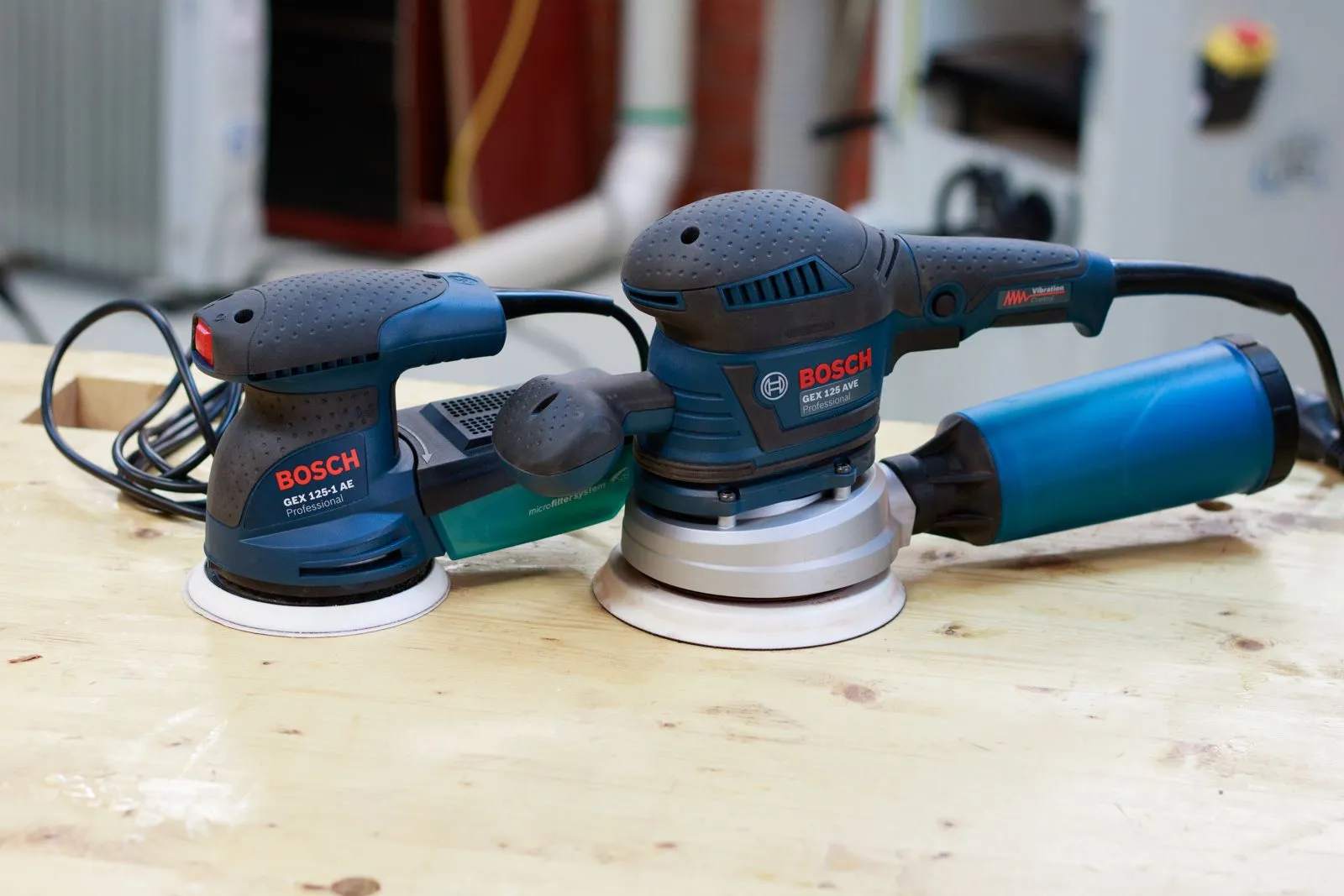
Although they’re both Bosch Blue (Bosch Green is DIY for most of the world, in the US I think a lot of that goes under the Skil brand), and thus aimed at trade, these two tools are kinda at the opposite ends of the spectrum. The 125-1 AE is an inexpensive, spartan sander while the GEX 125-150 AVE is a feature packed higher end tool. Lets look at the little guy first.
The GEX 125-1 AE
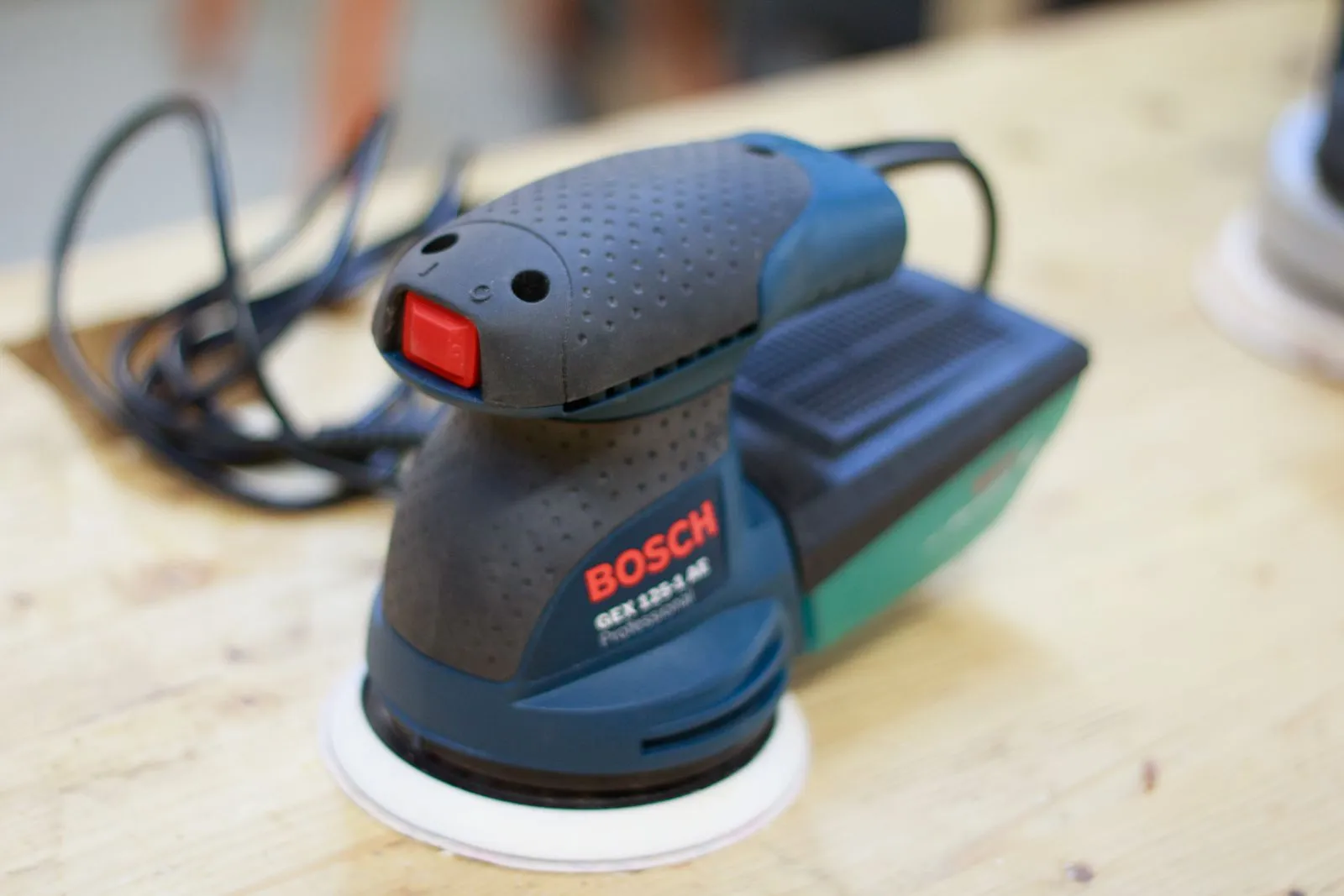
- ranges in speeds from 7500 to 12000 opm,
- takes 125mm sanding discs,
- 250w motor,
- an orbit radius of 2.5mm,
- weighs a paltry 1.3kg,
- Has a vibration emission value of 5m/s.
Before I dive into the good and bad of it, I have to mention the price. I’m going to take my pricing for tools where I can from TotalTools as they’re usually on par with others price wise and have stores nationally.
The GEX 125-1 AE street price is $111. By far, it is the cheapest “trade grade” sander on the market, with the next closest being a Hitachi unit at $199. Some of the downfalls of this sander are simply going to be forgiven because of that price.
Alright, so 125mm – not the size upgrade I was looking for, but it does let me compare it against the Makita BO5041 I have (which goes for $219).
Dust Collection
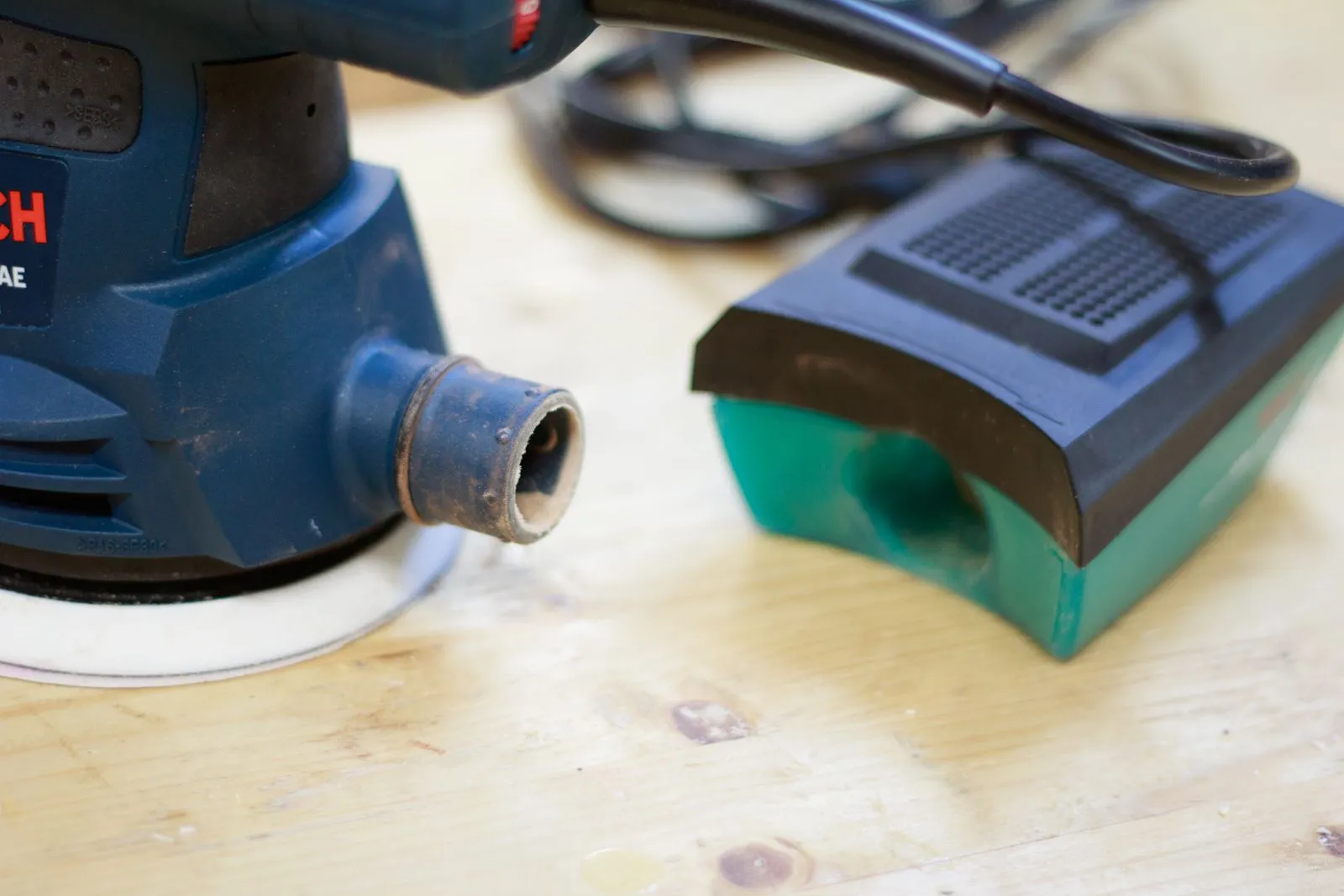

For dust collection, instead of a simple bag, the Bosch sander comes with a hard cannister with microfilter, a big plus if you can’t use a vacuum. Less dust is going to blow through the hard plastic compared to a bag, and the filter gives far more surface area. Pull off the cannister to reveal a proper sized dust port for hooking up to a vacuum. The downside with this particular cannister is the way everything snaps together – it can be difficult to notice if you do or don’t have a good fit. Its very firm. The competing Makita doesn’t’ have a standard port (its tiny), and while in other countries there appears to be an adapter, Makita Australia didn’t respond to the three emails I sent asking about it.
When hooked upto a dust collection, because of the lower powered motor, it is easy to stall it with vacuum pressure. My vacuum (Fein Dustex – highly recommend if you don’t want a “6HP screamer” from the big box stores) has a “tool collar with suction force regulation” which is basically just a port you can slide open. If I open that wide, no problems with dust extraction or stalling. I have been operating like this with other sanders anyway – they don’t stall, but to reduce the likely hood of swirlies. I think /u/joelav has this sander and I believe his solution was to get a shitty Home Depot vacuum.
Ergonomics
Being as light as it is, the sander is easy to operate vertically, and the tiny size does let it get into tight spots that bulkier sanders could not. Its not about the 125mm versus 150mm discs, its just a small, short sander. Its fairly comfortable, and allows you to grip it in several different positions – from the front, back or on top. I did find myself wanting an additional handle for balance, but that may be more personal preference and what I’m used to. My wife on the other hand loved this sander – she has smaller hands than me (though not overly dainty) and it was the perfect fit for her.
Vibration listed at 5m/s is on the higher side, but it honestly didn’t feel that high. It’s fairly comparable to the Makita, though a little less vibration. After a long sanding session I do get hand tingles, but not after 3 or 4 minutes (see the Milwaukee review for that)
I prefer my sanders – and most power tools in general – to have triggers with locks rather than just a power switch, which is unfortunately what the GEX 125-1 AE has. Its dust sealed and not too much of an issue, but the first time I used it I plugged it in and it started sanding as I’d knocked the switch. The power cable is fairly short and thinner when compared to higher end sanders like the Milwaukee ROS 150E-2 or Bosch GEX 125-150AVE, but in this end of the market it is expected – the Makita has about the same length.
Is it any good?
Is this the perfect sander? No, far from it. There are a few things I’d like changed – like a larger orbit size, or optional handle but its $111. However, had I known about this when I bought my Makita BO5041, I would have absolutely bought this instead – its lighter, has proper sized dust collection port built, and performs at least as well. However if I’d also known about the GEX 125-150 AVE, that’d be my pick.
Onto the GEX 125-150 AVE.
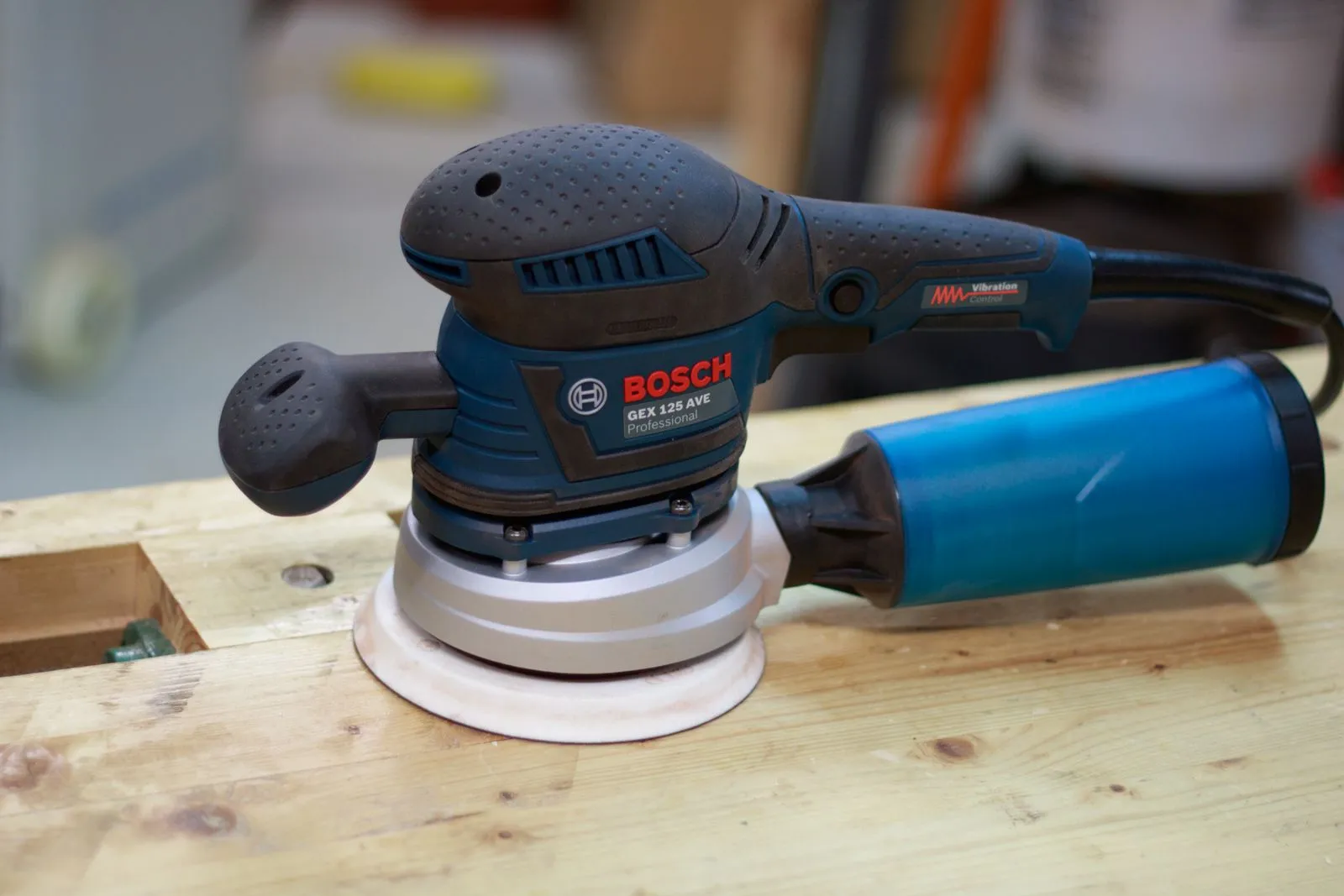
As the name suggests, the GEX 125-150 AVE can use either 125mm or 150mm sanding discs by changing the pad. Included in the box are a 125mm 8 hole pad, and a 150mm 6 hole pad. Other pads are available, ranging in firmness and a 150mm 8+1 pad for better dust extraction. By being able to change the pads, this gives you the best of both worlds – 125mm pads are cheaper and more readily available, while the 150mm pads are far more efficient covering 44% more surface area.
For me, this means the boxes of 80 and 120grit 125mm discs won’t go to waste.
The GEX 125-150 AVE features
- a more powerful 400w motor over its little brother (350w for 100v, I’m told)
- weighs in at 2.5kg
- an orbit radius of 4mm,
- and as far as I can see, an industry leading 2.5m/s vibration rating.
Ergonomics
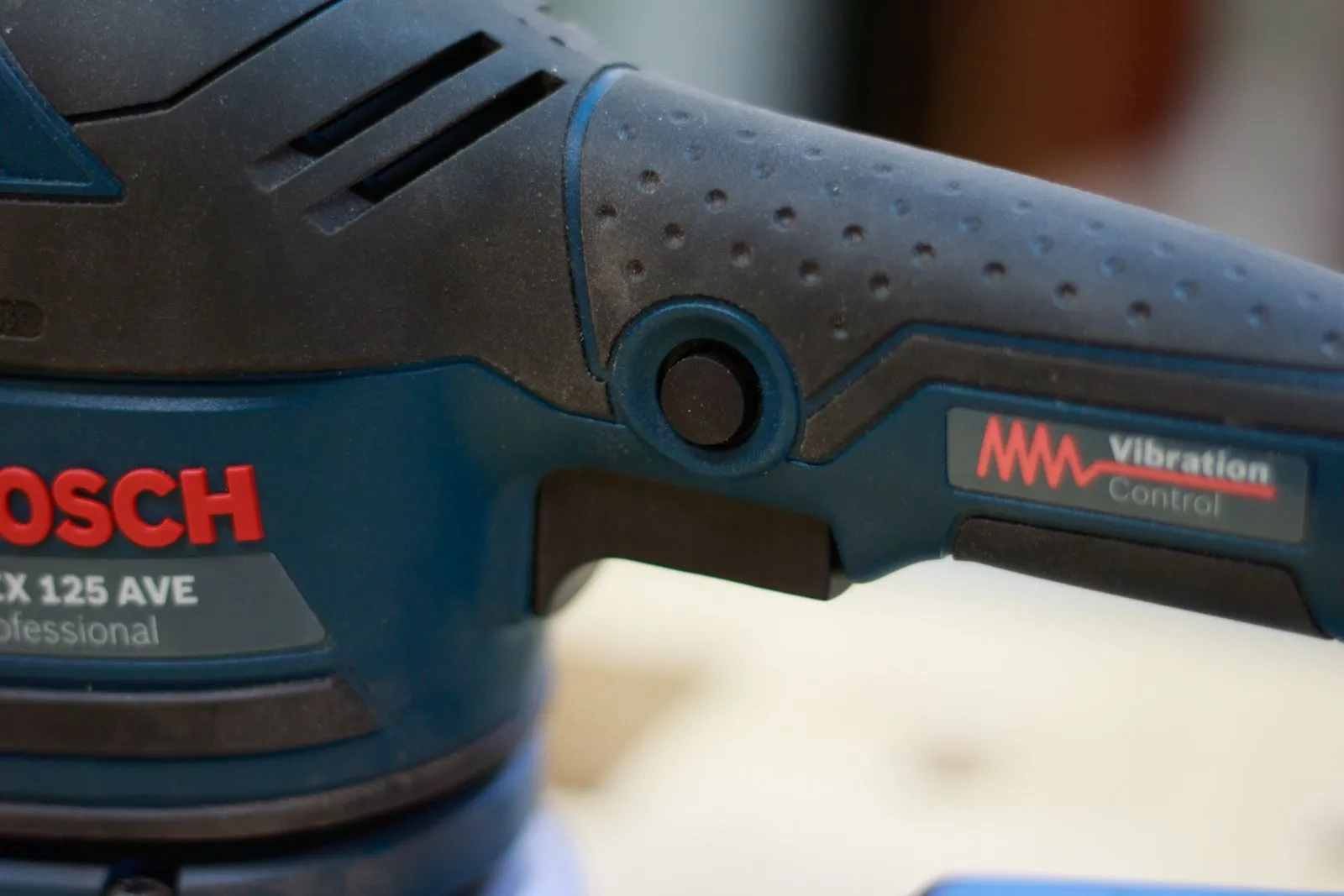
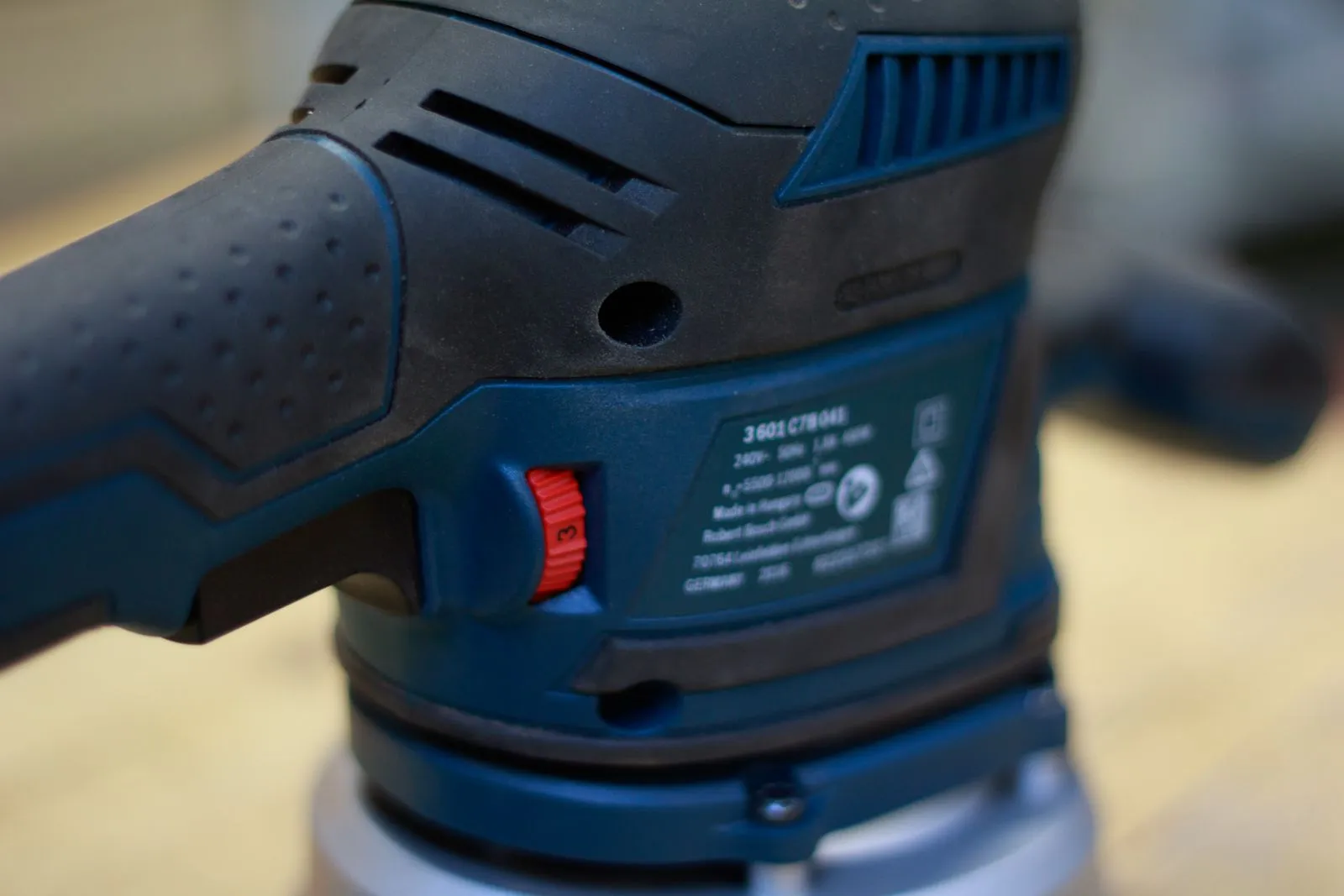
The marketing material (internal docs I got sent I think by mistake) around this sander all focuses on “Release your hands from buzz!”, and hyperbole aside, it kinda does. Bosch achieve this by decoupling the body from the sanding pad. In contrast with the recently reviewed Milwaukee sander, I could sand with this for hours before noticing any detrimental effects – if any at all.
While the vibration certainly sets the general ergonomics apart, I found this was a pretty comfortable sander to hold anyway. The handles were the right size, the trigger was easy to press, the trigger lock could be easily depressed with a thumb (unlike the Milwaukee) and the speed control dial was in a great spot (for a right hander I guess) to easily roll with a finger without changing grip. On the smaller Makita, its in an awkward enough position that you need to pull your hand back a little to properly adjust, and with the Milwaukee it so stiff and awkwardly recessed you almost need a flat head screwdriver. It is a tall-ish sander, though I didn’t find it particularly tippy one way or the other. At 2.5kg I’m not sure I’d sand vertical surfaces with it for long, but it’d be possible for short-ish bursts.
Power
With an orbit of 4mm, its neither overly aggressive or overly fine according to the industry definitions. To be honest, I don’t find the 4mm orbit any different in finish quality than others I’ve tried, but I typically go no higher than 300 grit before applying finish anyway. Perhaps if you’re using it in the automotive industry, needing 1000 grit or higher, it may be an issue. I did find that the 4mm was distinctly slower than the 6mm of the Milwaukee – in my test on sections of redgum, the Milwaukee was a good 30 seconds faster on the same surface area, while both took under 4 minutes to complete. It is still a massive speed upgrade from 125mm discs. The Milwaukee won the speed test but after the ~3minutes, I had to wait 20minutes or so for the vibration tingles to leave my hands.
Dust extraction
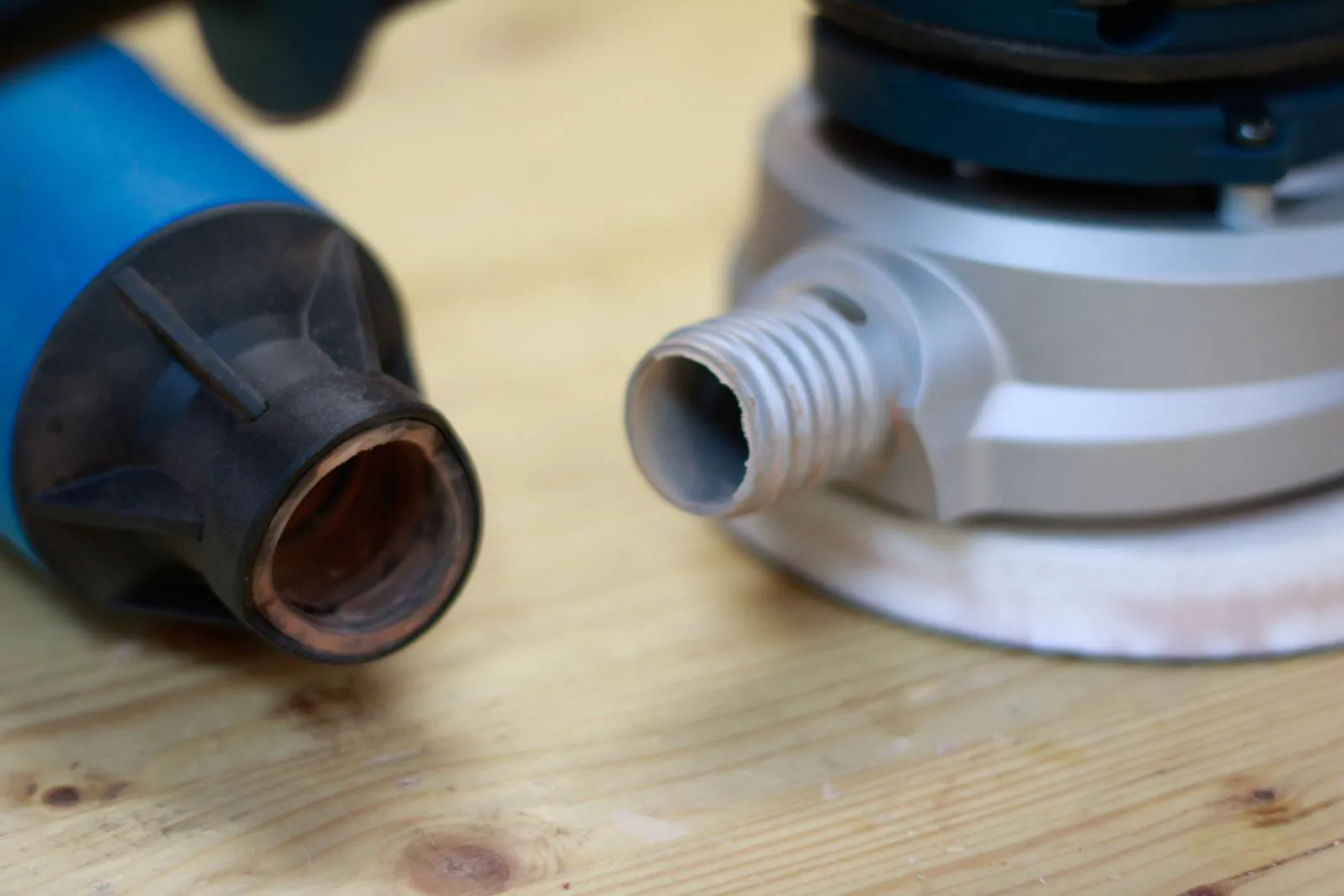
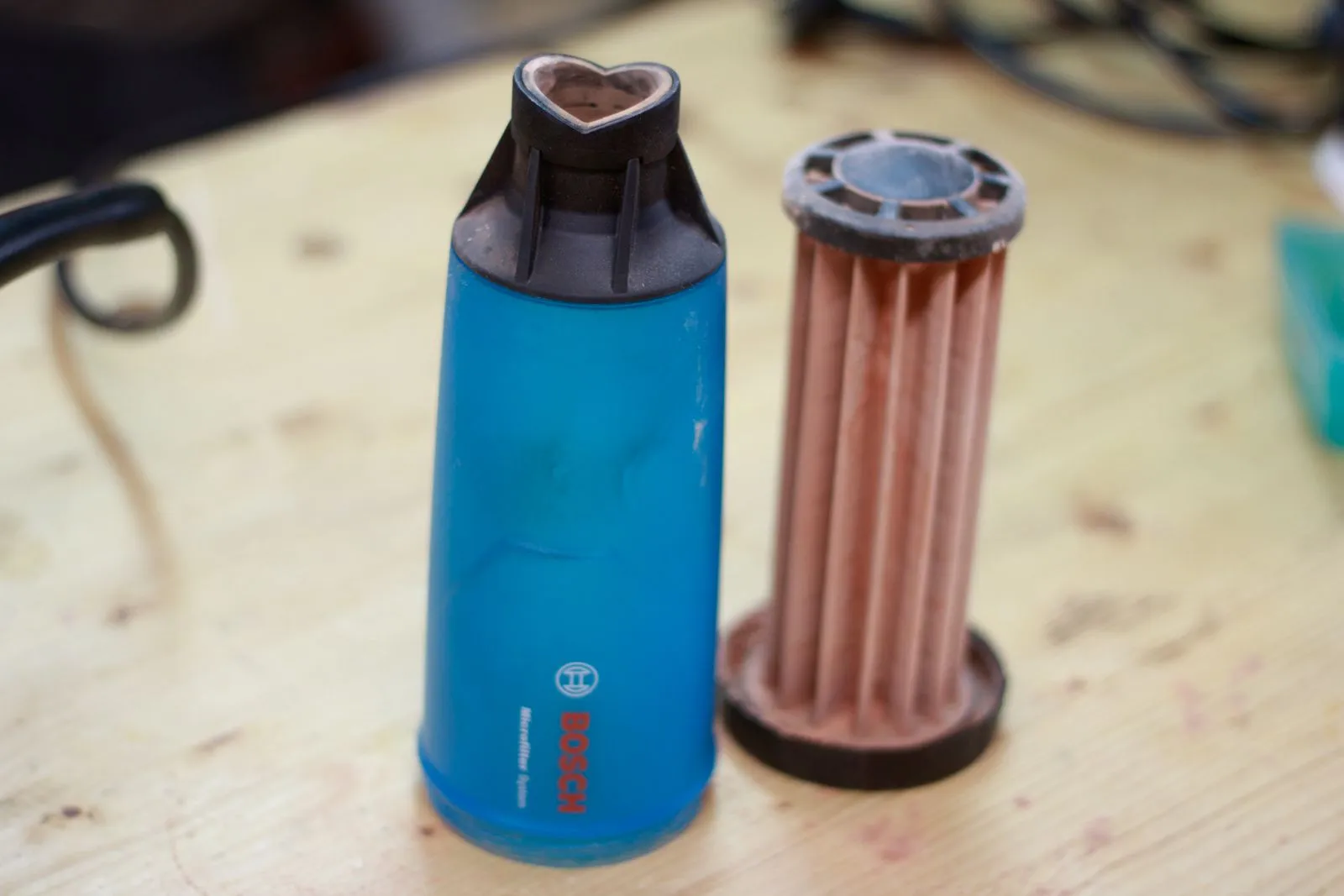 Just like its little brother, the provided dust box is a hard plastic with microfilter. This design is much easier to get off and on the sander, and even easier to clean out with a screw lid – you won’t be accidentally throwing dust in the air. Unlike its little brother there is no rubber gasket when you go to attach it to a vacuum, though there is the more standard ribbed connector design, and its much easier to attach. With the more powerful motor, there was no stalling with my vacuum with the tool collar fully open or closed.
Just like its little brother, the provided dust box is a hard plastic with microfilter. This design is much easier to get off and on the sander, and even easier to clean out with a screw lid – you won’t be accidentally throwing dust in the air. Unlike its little brother there is no rubber gasket when you go to attach it to a vacuum, though there is the more standard ribbed connector design, and its much easier to attach. With the more powerful motor, there was no stalling with my vacuum with the tool collar fully open or closed.
The dust collection via a vacuum was very good. Not much if anything left behind, and the internal dust extraction paths left the velcro pads and internals pretty clean.
Value for money?
Price wise, its almost double the GEX 125-1 AE at $229. Comparative to the rest of the market, its a bargain – its the cheapest 150mm sander and is only $10 more than the 125mm Makita!
In Australia, it is only available in one package – the box I have with two sanding discs, the two sanding pad sizes, the sander and the cannister. In other countries you can also find it in a package with an L-BOXX, plastic insert, and additional sanding pad – however that typically doubles the price of the sander. I can see the appeal of the L-BOXX and insert for protecting the additional pads, and for transporting everything safely, but a L-BOXX 238 can be bought for about $50, and some ‘tool tray’ foam for not a lot.
Conclusion
So there you go, two Bosch sanders and yet again (if you’ve watched my previous Bosch video reviews on their router or tracksaw) I sound like a Bosch fanboy. I’m not sure how I feel about this. They’re really aggressively priced sanders, with enough features, low enough vibration – nearly none for the GEX 125-150 AVE – and really good dust collection. With few options on the Australian market, these stand out as the best value in my opinion. Even if we had more options, they’d have to be something very special to beat the GEX 125-150 AVE in comfort.
Are they the absolute best? I can’t say with certainty – I feel like they’re up there. Mirka or Festool are renown for their sanders – particularly dust extraction, crazy low weight and low noise – and they most likely pip Bosch for top place-However, they’ll set you back two to four times as much as the GEX (ETS 150/5 is $515, not the -EC model. Mirka DEROS is crazy pricey over here). If you don’t want to spend five to nine hundred dollars, but still want a top notch sander with minimal vibration, the Bosch GEX 125-150 AVE is for you.
TL;DR: Bosch make some good sanders, priced well. The GEX125-150 AVE is the stand out with nearly no vibration, good to great ergonomics, and good dust extraction. The GEX 125-1 AE is more ‘no-frills’, but its a happy little sander